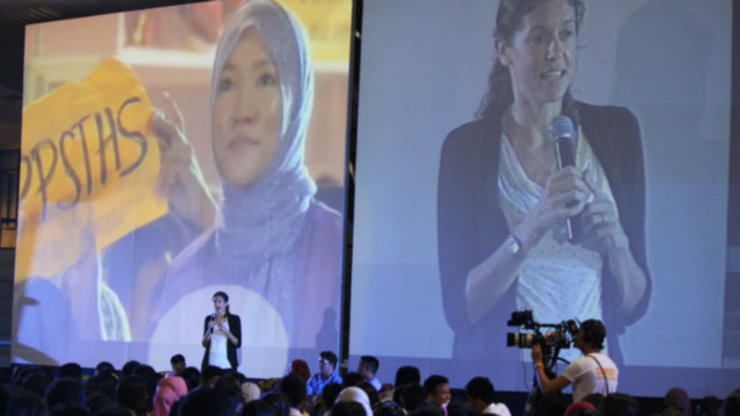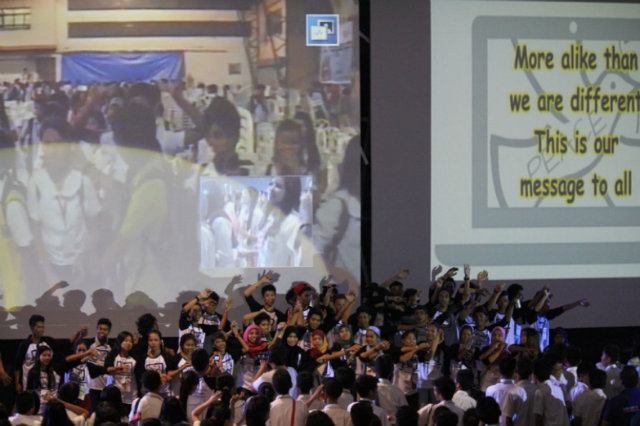One small group is fostering peace using technology and bridging together communities across the country

BRIDGES. Host Baicon Macaraya in Cotabato City speaking with Jennifer Foltz, Cultural Affairs Officer, US Embassy – Manila, in Zamboanga City. Photo by Bambina Wise
We live in an era where even terrorists and warlords have no qualms about posting beheadings on social media and watching the images go viral. Where celebrities bare their famous assets online and the internet promptly "breaks." Where women can be degraded on Twitter, cute cats and fashionable toddlers glorified on Facebook, and the profligate spending of corrupt politicians' offspring, revealed on Instagram.
But what if social media were used for purposes truly positive, truly constructive, and truly epic?
Some organizations may indeed choose to employ social media to sow terror. But there are others using it just as effectively for the opposite purpose – to build peace. One such organization, PeaceTech, is doing it right here in the Philippines.
PeaceTech Inc., a Philippine-based non-government organization, harnesses the power of technology via videoconferencing and social media, employing them as tools to bridge young people in Mindanao who are separated by distance and ignorance.
Using this model, PeaceTech teamed up with the US Embassy in Manila to launch a program they call EPIC – “Empowerment for Peace through Information and Communication."
With the support of Philippine Long Distance Telephone Company (PLDT), which generously provided a private high-speed line, the Embassy and PeaceTech demonstrated the reach of this new tool for peace-building in November 2014 in a massive videoconference connecting thousands of young people gathering in Cotabato and Zamboanga cities.
EPIC included high school students and out-of-school youth from two regions, which can show mistrust for one another – Central Mindanao, including Cotabato City, Maguindanao, North Cotabato, and Sultan Kudarat; and Western Mindanao, including Zamboanga City, Basilan, Sulu and Tawi-Tawi.
The ground-breaking videoconference, showed the youth via giant screens that the misperceptions they carried about one another were often the result of misinformation and the lack of communication.
To show the United States’ support, US Ambassador Philip Goldberg flew to Zamboanga City to speak live to the thousands of young people through the screens: “All of you, standing together, can make a difference.
“What we are really here to do today is to help young people create a better future, to look forward, and to be able to have a real impact on your communities, on your city, on your country. And that’s why we support the EPIC Program.”
Noralyn Lumbatan, 22, an out-of-school youth from Datu Odin Sinsuat, Maguindanao watched the Ambassador from Cotabato City: “I (now) realize that my negative perception about the people of Zamboanga, Basilan, Sulu and Tawi-Tawi would not have changed if it had not been for EPIC.”
Pinky Angga, 19, an out-of-school youth from Datu Blah Sinsuat, Maguindanao agreed: “At first, I really thought the people from Basilan and Sulu were kidnappers and killers, but because of EPIC and the technology like the Mass Videoconference, I learned that they are also nice and joyful people like us.”
On the other side of the videoconference, Tony Jamid, 21, of the municipality of Sitangkai, Tawi-Tawi felt the same: “I didn't think that they were the same as us, not until we saw them and interacted with them. I realized that we have same 'hopes, same dreams and same expectations' just like in the EPIC Song.”
There were several truly “Aha!” moments, as the youngsters began to realize, as they became more aware of how “the other side” lived, that they had so much in common. And they also began to appreciate that they all had a voice, and could be heard, even the young people at risk of fighting in conflict. They were empowered in a way their parents had never experienced.
“My father told me that we the youth are very lucky nowadays since we have technology, and this can help us to know and meet different kinds of people in other places, and maybe the rest of the world,” said 18-year old Shira Guiamalo of Midsayap, North Cotabato.

Youth perform
during the PeaceTech event
It was not just the young who were impacted: “I never imagined…what PeaceTech is and what they do until I saw the MVC. It's really amazing what technology can do these days. People from different places are talking to each other as if they're face-to-face. This creates a huge impact in reducing conflict among people,” said Sol Mangumma, 54, of Zamboanga City, who was helping distribute food at the activity.
The videoconference was historic in other significant ways. Former “enemies” involved in conflict came face-to-face, courtesy of the video screens, such as a marine who lost his leg in a joint MILF-MNLF ambush in Lanao del Norte and a former MNLF fighter from Sultan Kudarat. Joining them were a MNLF hostage victim of the 2013 Zamboanga City siege and Edmund Gumbahali, an MNLF member who was himself a hostage of the Abu Sayyaf when he was kidnapped in 2012. He recalled matter-of-factly: “They mentally tortured me. They kept telling me: ‘Tomorrow, we will behead you…”
Conflict can sometimes seem the only mode of existence for these communities, acknowledges PeaceTech president Gianna Montinola.
The videoconference was historic in other significant ways. Former “enemies” involved in conflict came face-to-face, courtesy of the video screens, such as a marine who lost his leg in a joint MILF-MNLF ambush in Lanao del Norte and a former MNLF fighter from Sultan Kudarat. Joining them were a MNLF hostage victim of the 2013 Zamboanga City siege and Edmund Gumbahali, an MNLF member who was himself a hostage of the Abu Sayyaf when he was kidnapped in 2012. He recalled matter-of-factly: “They mentally tortured me. They kept telling me: ‘Tomorrow, we will behead you…”
Conflict can sometimes seem the only mode of existence for these communities, acknowledges PeaceTech president Gianna Montinola.
“But it’s not a situation they necessarily want to find themselves in; it’s just that they have never known any other way – until now. And with technology dominating the lives of young people more and more, the possibilities for greater understanding – and lasting peace - are limitless. That’s why a program like EPIC is so important.”
The US Embassy has been a key partner with PeaceTech in making EPIC a reality, firmly believing that social media can have a significant impact among the youth in conflict-affected areas.
Jennifer Foltz, Cultural Affairs Officer at the US Embassy in Manila said: “One of our priorities is reaching out to young people, especially young people who want to improve their communities, who want to bring peace, who want to fix challenges with education… so when our partner in this program PeaceTech told about this awesome idea, we worked together to make this program happen.”
Using ICT and social media to connect groups within Mindanao might become a model, which PeaceTech and partners apply in other regions including the Middle East where groups are equally divided by ignorance. It’s easy to blame the enemy,” says PeaceTech founder Robin Pettyfer.
“But we believe that ignorance is the real enemy here and not other people. And that gives us hope because today we have the ability to connect people in the remotest places through programs like EPIC so they too can realize that what they are told about one another might in fact not be true.”
[Bambina Olivares Wise is a correspondent for the New York-based fashion trade daily, Women's Wear Daily (WWD). She got involved with PeaceTech after returning to the Philippines.]

No comments:
Post a Comment
Note: Only a member of this blog may post a comment.